Digital Poster
Generating Synthetic Imaging Data: Part II
ISMRM & ISMRT Annual Meeting & Exhibition • 10-15 May 2025 • Honolulu, Hawai'i

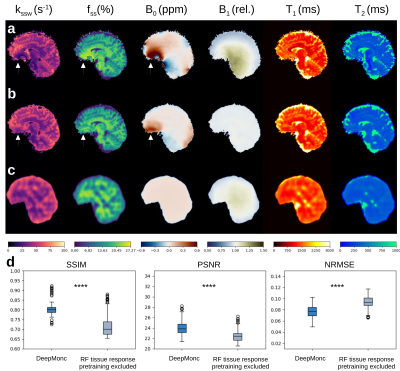 |
Computer Number: 49
3232. Multi-Contrast
Generation and On Demand Quantification of Saturation Transfer,
Relaxivity, and Field Homogeneity using a Deep MRI on a Chip
D. Nagar, M. Zaiss, O. Perlman
Tel Aviv University, Tel Aviv, Israel
Impact: A deep learning framework was designed to
provide rich biological information in less than 30 seconds.
It can capture the magnetic signal dynamics in humans and
decode the tissue response to RF excitation, constituting a
deep MRI on a chip.
|
|
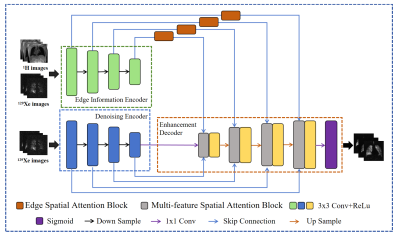 |
Computer Number: 50
3233. Hyperpolarized
129Xe MR Image Denoising Model Based on Multimodal Edge
Information
M. Zhang, S. Xiao, S. Shi, X. Zhou
State Key Laboratory of Magnetic Resonance and Atomic and Molecular Physics, National Center for Magnetic Resonance in Wuhan, Wuhan Institute of Physics and Mathematics, Innovation Academy for Precision Measurement Science and Technology, Chinese Academy of Sciences–Wuhan National Laboratory for Optoelectronics, Huazhong University of Science and Technology, 430071, wuhan, China
Impact: Our proposed image denoising model combines
multimodal edge information and uses the attention mechanism
to increase the weight of important information, which
effectively improves the image details and quality, and
improves the help for the clinical assessment of related
diseases.
|
|
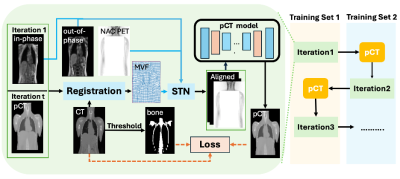 |
Computer Number: 51
3234. SRIP:
A Self-Refined Iterative Pipeline to Integrate Whole Body MRI-CT
Registration and Pseudo-CT Generation
J. Hu, H. Yousefi, T. Fraum, J. Crandall, R. Wahl, R.
Laforest, Y. Chen, H. An
Washington University in St. Louis, St. Louis, United States
Impact:
SRIP introduces a novel pCT generation pipeline that produces high-quality pCT images through a fully automated approach, demonstrating the potential for various applications, such as radiation therapy and PET attenuation correction. |
|
 |
Computer Number: 52
3235. Diffusion-guided
MR Brain Tumor Segmentation with Missing Modalities
Y. Zhang, Y. Huang, J. Qi
GE Healthcare, Beijing, China
Impact: This approach enhances brain tumor segmentation
accuracy and consistency, even with missing MRI modalities,
thereby improving diagnostic precision and supporting
clinical decision-making.
|
|
 |
Computer Number: 53
3236. Attention-Based
Inverted Minimum Intensity Projection-Guided GAN for 7T-Like SWI
Generation from 3T SWI
W. Tang, R. Zheng, Y-H Chu, C. Wang, H. Wang
Institute of Science and Technology for Brain-Inspired Intelligence, Fudan University, Shanghai, China
Impact:
This study was an early exploration of artificial intelligence methods in the field of cross-field-strength SWI image generation. It provided insights for related research on enhancing the image quality and diagnostic capability of low-field MR images. |
|
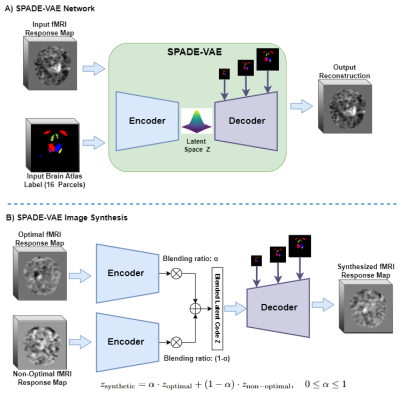 |
Computer Number: 54
3237. Label-informed
Data Augmentation for DBS Optimization: Synthesizing fMRI Maps
with SPADE-VAE Network to Improve DBS Parameter Classification
J. Qiu, A. Ajala, J. Germann, B. Santyr, D. Yeo, L.
Marinelli, A. Boutet, A. Lozano
GE HealthCare, Niskayuna, United States
Impact: By producing realistic synthetic DBS-fMRI maps,
the trained SPADE-VAE model addresses data gap issues in
DL-based fMRI-DBS optimization, corrects class imbalances,
enhances classification accuracy and ultimately reduces the
time to optimization per patient in Parkinson’s disease
treatment.
|
|
 |
Computer Number: 55
3238. DTI
with Minimal Data: Image Translation Based Distortion Correction
and FA Map Generation for Clinical Efficiency
Y. Cui, H. Qi, Z. Zhang, H. Zhang, S. Yuan, B. Cai, J. Li,
M. Zhang, Z. Wang, L. Tong, J. Luo
School of Biomedical Engineering, Shanghai Jiao Tong University, Shanghai, China
Impact: Success of the proposed pipeline will enable
much shorter DTI acquisition time for patients who cannot
stay still throughout a multidirectional DTI scans, which
holds great potential to becoming a promising tool for
clinical applications.
|
|
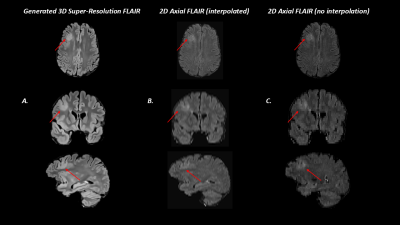 |
Computer Number: 56
3239. Generation
of 3D Super-resolution FLAIR Images from Heterogeneous 2D FLAIR
Acquisitions in Epilepsy Patients
S. Morris, T-Y Su, A. Alexopoulos, I. Najm, Z. Wang
Cleveland Clinic, Cleveland, United States
Impact: Our method can assist clinicians to evaluate the
existence and the extent of epileptic lesions in
data-limited situations in various health care settings. The
generated images may also serve as inputs to inform AI
models for automated lesion detection.
|
|
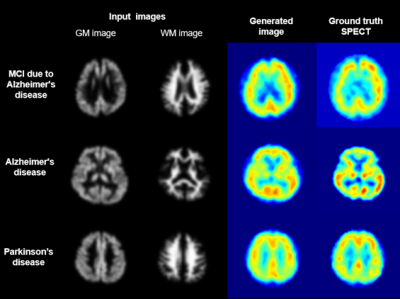 |
Computer Number: 57
3240. Generation
of 123I-IMP brain SPECT from 3D T1-weighted imaging using a
machine-learning-based model
S. Okuchi, Y. Fushimi, K. Fujimoto, T. Seguchi, A. Iohara,
S. Nakajima, A. Sakata, T. Yamamoto, S. Otani, A. Sakurama,
S. Ikeda, S. Ito, M. Umehana, Y. Ma, S. Morooka, J.
Fujimoto, S. Shinjo, Y. Nakamoto
Graduate School of Medicine, Kyoto University, Kyoto, Japan
Impact: This study shows that a machine learning model
trained on a combined dementia and Parkinsonism dataset can
generate accurate SPECT-like images from MPRAGE, potentially
reducing the need for traditional SPECT imaging in
neurological assessments.
|
|
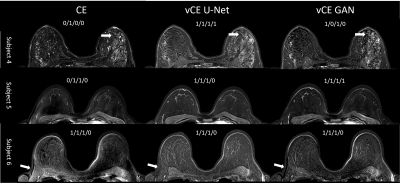 |
Computer Number: 58
3241. Turing
Testing the Realism of U-Net, GAN, and Real Images for Virtual
Contrast-Enhanced Breast MRI
A. George, H. Schreiter, J. Hossbach, T-T Nguyen, I.
Horishnyi, C. Ehring, S. Heidarikahkesh, L. Kapsner, F.
Laun, S. Ohlmeyer, M. Uder, S. Bickelhaupt, A. Liebert
Institute of Radiology, Uniklinikum Erlangen, Friedrich-Alexander-Universität Erlangen-Nürnberg, Erlangen, Germany, Erlangen, Germany
Impact: DL-based vCE provides an effective alternative
to significantly reduce reliance on contrast agents,
addressing concerns of cost, time, and contraindications.
Incorporating adversarial training enables the model to
learn intricate details of contrast-enhanced images,
resulting in more realistic outputs.
|
|
 |
Computer Number: 59
3242. Self-Supervised
Isotropic MRI Volume Restoration from Complementary
Contrast-Plane Acquisition using Two-Phase Fast Score-based
Models
H. Kim, Y. Song, T. Çukur, D. Hwang
Yonsei University, Seoul, Korea, Republic of
Impact: This method enhances clinical MRI protocols by
enabling isotropic multi-contrast volume reconstruction from
anisotropic data, improving diagnostic consistency across
contrasts. It reduces the need for extended scan times,
maximizing data utility and facilitating broader clinical
insights in routine practice.
|
|
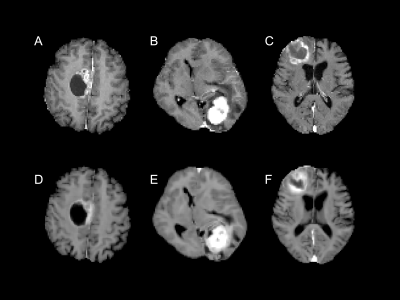 |
Computer Number: 60
3243. AI-based
Synthetic Contrast-enhanced MR Images from Noncontrast MR Images
for Various Brain Tumors beyond Gliomas
H. Takita, H. Tatekawa, K. Nakajo, T. Uda, Y. Mitsuyama, S.
Walston, Y. Miki, D. Ueda
Graduate School of Medicine, Osaka Metropolitan University, Osaka, Japan
Impact: Our study suggests potential clinical
applicability of AI-based synthetic contrast-enhanced MR
images generated from noncontrast MR images across various
brain tumor types, offering a promising alternative for
patients unable to receive gadolinium-based contrast agents.
|
|
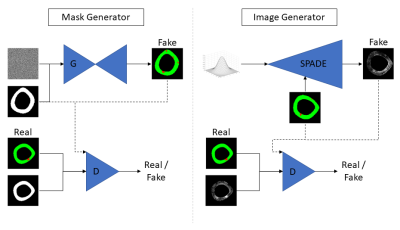 |
Computer Number: 61
3244. Generating
Synthetic Late-Gadolinium Enhancement Images for Training Scar
Segmentation Networks
I. Margolis, L. Dal Toso, S. Buoso, S. Kozerke
ETH Zurich, Zurich, Switzerland
Impact: This study presents a GAN-based framework to
generate high-variability synthetic LGE images for scar
segmentation, achieving realistic scar patterns and
outperforming real-image networks and standard augmentation.
|
|
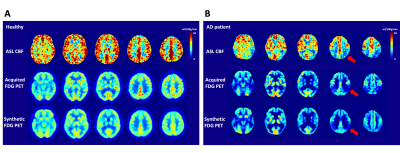 |
Computer Number: 62
3245. Synthesizing
PET images with ASL CBF for AD diagnosis
Q. Shou, D. Wang
University of Southern California, Los Angeles, United States
Impact: This study provides the proof-of-concept that
noninvasive ASL can be applied to synthesize PET images for
the diagnosis and management of AD without the cost and
radiation exposure of an actual PET scan.
|
|
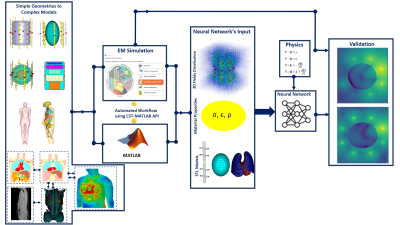 |
Computer Number: 63
3246. Prediction
of EM Field in a Simple Homogenous Phantom at UHF MRI Using
Physics-Informed Neural Networks (PINNs): Methodology in Data
Generation
F. Jabbarigargari, A. Dulny, M. Terekhov, A. Krause, A.
Hotho, L. Schreiber
Comprehensive Heart Failure Center, University Hospital Wuerzburg, Wuerzburg, Germany
Impact: This study proposes a deep learning-based method
for EM field prediction, which, by significantly reducing
the computational time, can enable safer and more accessible
7T MRI.
|
|
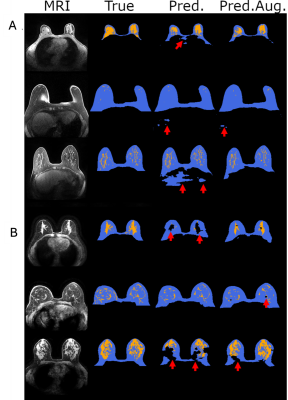 |
Computer Number: 64
3247. Counterfactual
MRI Data Augmentation using Conditional Denoising Diffusion
Models:training AI for different clinical scenarios
J. Santinha, P. Morão, Y. Forghani, N. Loução, T. Correia,
P. Gouveia, M. Figueiredo
Breast Unit/Digital Surgery LAB, Champalimaud Foundation, Lisboa, Portugal
Impact: This method can improve the performance of DL
models in clinical settings by enabling them to generalize
across different acquisition settings. This could lead to
more reliable and robust diagnoses, particularly in
scenarios with limited access to diverse training data.
|
The International Society for Magnetic Resonance in Medicine is accredited by the Accreditation Council for Continuing Medical Education to provide continuing medical education for physicians.